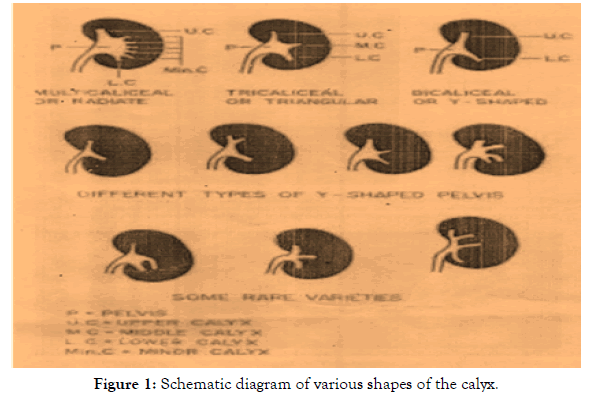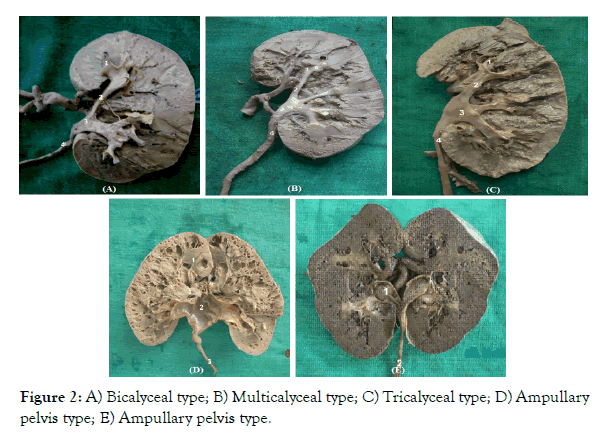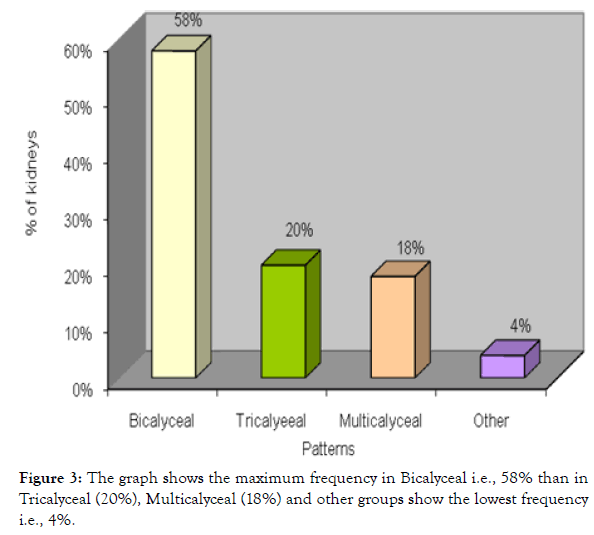Anatomy & Physiology: Current Research
Open Access
ISSN: 2161-0940
ISSN: 2161-0940
Research Article - (2019)Volume 9, Issue 1
Introduction: In our study, the aim was to study the pelvicalyceal system of human kidneys and its variation. The extensive knowledge of the anatomical pattern of pelvicalyceal of human kidneys will be beneficial to the radiologist and surgeons during the surgery like Nephrectomy, Radical nephrectomy, Ureteroscopy, and also has a role in the treatment of renal calculi like shock wave lithotripsy, percutaneous nephrolithotomy, and nephrolithotripsy.
Methods and Results: Pelvicalyceal system of 50 human kidneys were studied to note on different shapes by dissection method in Indian people and the commonest shape was bicalyceal 29 (58%) while tricalyceal 10 (20%), multi calyceal 9(18%) and ampullary pelvis/another group (absent of major calyx) showed 2 (4%).
Conclusion: Knowledge of these variations is important during management of renal calculi.
Pelvicalyceal system; Kidney; Renal pelvis
“The kidneys are so beautifully organized, they do their work of regulation with such a miraculous, it’s hard to find another wordsuch a positively divine such knowledge and wisdom that there is no reason why our archetypal man, whoever he is, or anyone else, for that matter, should be ashamed to own a pair.”
The Kidneys (Renes) are excretory organs of our body. They excrete final products of metabolic activities and excess water. The kidneys are a pair of organs found along the posterior muscular wall of the abdominal cavity, extending from T12 to L3 vertebrae. The left kidney is situated slightly more superior than the right kidney, due to the larger size of the liver on the right side of the body [1].
The pelvicalyceal system formed by the renal pelvis, major and minor calyces. The renal calyces are chambers of the kidney through which urine passes. The minor calyces are cup-shaped and 7-13 in number, encompass the apex of the renal pyramid.
The neck of the minor calyx is a narrow structure called infundibulum, and two or three minor calyces converge to form major calyces which open into renal pelvis with an angle [2]. The pelvis is the funnel-like the upper dilated end of the ureter.
The patterns of the pelvicalyceal system shows different shapes depending on the number of major calyces and the angle, it makes with the ureter: Triangular or tricalyceal (40%), Radiate or multi calyceal (30%), Y-shaped or Bicalyceal (20%) and some unusual forms (10%) (Figure 1).

Figure 1. Schematic diagram of various shapes of the calyx.
• Multicalyceal or Radiate type (30%): The major calyces are more than three in number, which directly open into the renal pelvis. The pelvis is biggest in this category and no distinct anterior and posterior divisions of the middle calyx are seen. Infundibula of the minor calyces are so short that they open directly into the pelvis
• Triangular type or Tricalyceal (40%): The cup-shaped minor calyces join and form major calyces. The tricalyceal has three major calyces-superior, middle and inferior calyces, combine and open into renal pelvis with angulations. In case of management of renal calculi, the lower calyx is more in peril than the other calyces because angulations between lower calyx and renal pelvis, is more curved than others, so it causes difficulty in removal of the stone and it becomes more dangerous to the patient. The renal pelvis moderate in size and infundibulum is longer
• Y-shaped pelvis or Bicalyceal (20%): It has two major calyces one each from the upper and lower poles, so upper and lower zones of the kidney are drained through there corresponding calyces while the middle zone is dependent to drain into either upper calyx or lower calyx. Infundibulum of the minor calyx is a little longer
• According to the length of stem, it is of two types:
a) Classical Y-shape: It has two major calyces, upper and lower, which shows a mirror image to each other. Each calyx receives 4-5 minor calyces and both calyces are drain their respective zone of kidney and the middle zone is drained by either upper or middle calyx.
b) Asymmetrical type: It has two dissimilar major calyces, upper and lower. One is longer and dominant type than the other one and the midzone is drained by dominant calyx [2].
Variation of the pelvicalyceal system and embryological anomalies of the kidney is numerous and very common but bilateral collecting system is very different even in the same person [3].
The enlightenment of deep calyceal anatomy is very essential for surgery like percutaneous nephrostomy and percutaneous nephrolithotomy and lithotripsy are very effective to treat kidney stones and ureter diseases. Extracorporeal shock wave lithotripsy uses highly focused impulses projected and focused from outside the body to pulverize kidney stones anywhere in the urinary system [4,5].
These days for abdominal pain renal calculi are found accidentally so the knowledge of the pelvicalyceal system is very important for the clinician, surgeon, urologist nephrologist and radiologist for treatment and diagnosis. Detailed caliceal anatomy is also important for intravenous pyelogram, is an important procedure for the diagnosis of kidney related ailments, an intravenous pyelogram also called an intravenous urogram, is a radiological procedure used to visualize abnormalities of the urinary system, including the kidney, ureters, and bladder [6].
Lower pole infundibulopelvic angle is formed by ureteropelvic axis and central axis, it is very commonplace for stone formation and treated by extracorporeal shock wave lithotripsy but sometimes, extracorporeal shock wave lithotripsy is considered a failure if residual stone fragments remain after surgery, so for the residual stone free surgery, surgeons should know the width and length of infundibulopelvic angle and have the proper knowledge of pelvicalyceal anatomy [7].
The pattern of pelvicalyceal in the 50 kidneys was studied by dissection method. The incision was given in abdomen and the kidneys were separated along with the renal arteries by removal of soft tissues, muscles layer and the piece of the aorta.
Adult human kidneys from the dissection cadavers were washed in running tap water to remove the formalin. The capsule of each kidney was stripped off and the parenchymatous tissue was removed in piecemeal with forceps under water, tracing the pelvicalyceal as much as possible. The dissected specimens were numbered and allowed to dry for a time. The patterns of pelvicalyceal were observed and photographed. Specimens were preserved in 5% formalin.
The mean values are 32.08 and degree of freedom is 3, and it’s significant, the parameters were determined by using chi-square test statistical program, which is shown in Table 1.
| S. No. | Patterns | No. of kidneys | % |
|---|---|---|---|
| 1 | Bicalyceal | 29 | 58% |
| 2 | Tricalyceal | 10 | 20% |
| 3 | Multicalyceal | 9 | 18% |
| 4 | Other/Ampullary pelvis | 2 | 4% |
X²-value=32.08, (chi-square test); do (degree of freedom)=3; Significant
Table 1: Shapes of the pelvicalyceal system.
The mean values are 32.08 and degree of freedom is 3, and it’s significant, the parameters were determined by using chi-square test statistical program, which is shown in Table 1.
We studied and observed the pattern of the pelvicalyceal system in human kidneys and classified it, according to the numbers of the major calyx (Figure 2).

Figure 2. A) Bicalyceal type; B) Multicalyceal type; C) Tricalyceal type; D) Ampullary pelvis type; E) Ampullary pelvis type.
1) Bicalyceal type- It has two major calyces, minor calyces open into it and major calyces open in the renal pelvis
2) Tricalyceal type- It has three major calyces
3) Multicalyceal type- It has more than three major calyces
4) Ampullary pelvis- absent of major calyces
We observed that commonest pattern was bicalyceal, 29(58%) while tricalyceal, 10(20%), multi calyceal, 9(18%) and other groups (absent of major calyx) showed, 2(4%) (Figure 3).

Figure 3. The graph shows the maximum frequency in Bicalyceal i.e., 58% than in Tricalyceal (20%), Multicalyceal (18%) and other groups show the lowest frequency i.e., 4%.
The commonest pattern seen was calyceal (58%) followed by tricalyceal (10%), multi calyceal (9%) and others or absent of major calyx (2%). The findings were similar with more or less those of Ningthoujam, et al. [3] who studied the pelvicalyceal patterns in both fetuses and adults kidneys and simplified the patterns of pelvicalyceal than the previous workers and they found the commonest pattern was triangular or tricalyceal (40% in fetus and 51% in adults), Y-shaped or calyceal (20% in fetus and 22% in adults). Radiate or multi calyceal (30% in the fetus and 15% in adults) and others (10% in the fetus and 12% in an adult). Our findings did not correlate with both of this probably due to variation in sample size.
Palma et al. [8] studied in 208 kidneys and observed bifid pelvis whether simple or complex in 37.5% (simple bifid in 13.0% and complex bifid in 24.5%) in contrast to trifurcate in 54.3% and ampullary in 8.2%. Sampaio et al. [9] studied 140 pelvicalyceal patterns of the kidney through the polyester endocast and found, calyceal (62%) in which upper and lower zone of kidney were drained through their corresponding calyces but mid zone was drained by either upper or lower calyx and tri or multi calyceal (38%), in which mid zone was drained by their corresponding calyx.
In another study of the pelvicalyceal system of the kidney, Fine et al. [10] reported the calyceal in the majority of cases than the tricalyceal. Bruce et al. [11] observed the position of renal pelvis related to renal sinus, sometimes half of the renal pelvis lie inside and half of the renal pelvis lies outside the renal sinus. Occasionally renal pelvis is absent also Didio [12] studied and described two types of the renal pelvis. One type has long major calyces with small renal pelvis while other has short major calyces in length with the large renal pelvis. Anson et al. [13] highlighted the extrarenal type of pelvis, situated outside of the kidney, is larger than the intrarenal type, situated inside the kidney, which is smaller. According to Harrison [14], a number of miner calyces is 8 to 9 in the adult. Webb et al. [15] described three cases with an abnormal short calyx without a papilla within the kidney, which is related to congenital abnormality. In today’s world, embryological anomalies of the kidney and pelvicalyceal system are a very common and significant cause of morbidity.
Edwards et al. [16] reported two types of renal pelvis in their studies: i) intrarenal-renal pelvis situated inside the kidney and ii) extrarenal-renal pelvis situated outside the kidney.
Hodson [17] found that anterior calyces project laterally and posterior calyces project medially. This arrangement is the exact mirror image of that of Brodel.
The pelvicalyceal pattern of total 50 kidneys were studied by dissection methods and observed that the maximum frequency in Bicalyceal (58%), then in Tricalyceal (20%), Multicalyceal (18%) and another group (Others or absent of major calyx) showed the lowest frequency i.e., (4%). Understanding of such wide-ranging patterns of pelvicalyceal anatomy would help the surgeons and interventional radiologists in planning and executing their procedures more accurately and also helps to avoid unnecessary bleeding.
Citation: Patel S, Naik A (2019) Morphological Study of Pelvicalyceal System of Kidney in Human Cadavers. Anat Physiol 9: 1000314.
Received: 07-Mar-2019 Accepted: 22-Mar-2019 Published: 29-Mar-2019
Copyright: © 2019 Patel S, et al. This is an open-access article distributed under the terms of the Creative Commons Attribution License, which permits unrestricted use, distribution, and reproduction in any medium, provided the original author and source are credited.